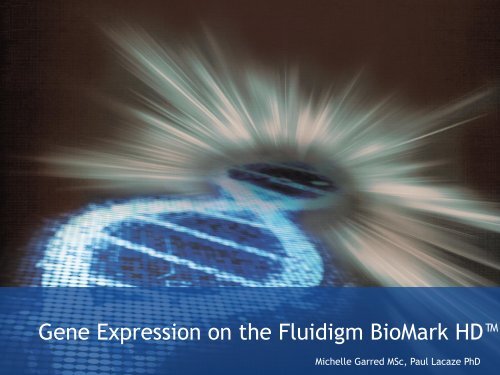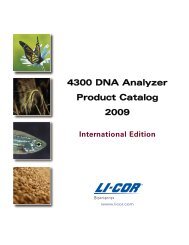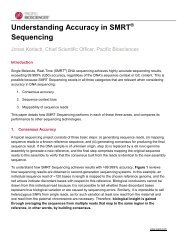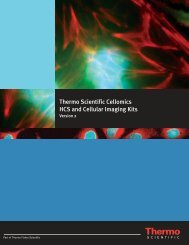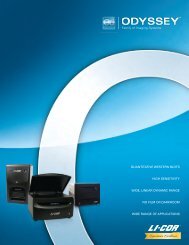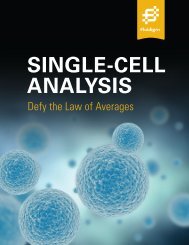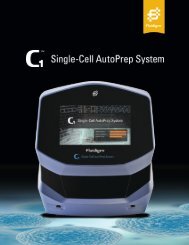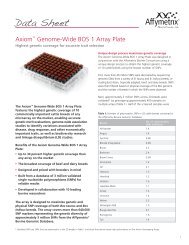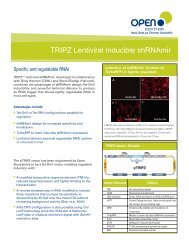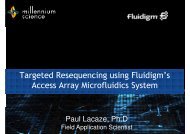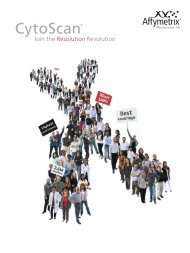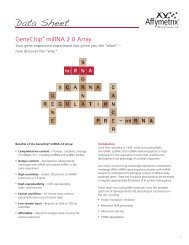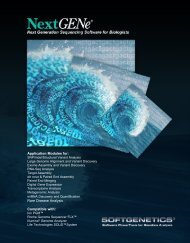Gene Expression on the Fluidigm BioMark HD
Gene Expression on the Fluidigm BioMark HD
Gene Expression on the Fluidigm BioMark HD
Create successful ePaper yourself
Turn your PDF publications into a flip-book with our unique Google optimized e-Paper software.
<str<strong>on</strong>g>Gene</str<strong>on</strong>g> <str<strong>on</strong>g>Expressi<strong>on</strong></str<strong>on</strong>g> <strong>on</strong> <strong>the</strong> <strong>Fluidigm</strong> <strong>BioMark</strong> <strong>HD</strong><br />
Michelle Garred MSc, Paul Lacaze PhD
Overview<br />
• Introducti<strong>on</strong> to <strong>Fluidigm</strong> (Michelle)<br />
• Advantages of <strong>the</strong> technology<br />
• Running a <strong>Fluidigm</strong> gene expressi<strong>on</strong> project (Paul)<br />
• Assay design – Taqman vs EvaGreen<br />
• Experimental workflow<br />
• Data analysis<br />
• Case study
<strong>BioMark</strong> <strong>HD</strong> Real-Time PCR System<br />
High-throughput qPCR based microfluidic technology for DNA,<br />
RNA, miRNA analysis and next-gen library prep
Advantages of <strong>Fluidigm</strong> Technology<br />
Network of microfluidic channels,<br />
chambers, and valves<br />
Automatically assemble thousands of<br />
individual PCR reacti<strong>on</strong>s<br />
Greatly decrease number of pipetting<br />
steps<br />
Decrease amount of sample and<br />
reagent used
1,300
Technology
Dynamic Arrays: <str<strong>on</strong>g>Gene</str<strong>on</strong>g> <str<strong>on</strong>g>Expressi<strong>on</strong></str<strong>on</strong>g><br />
96.96 48.48<br />
9,216 data points 2,304 data points
Open Nanoflex Valve<br />
C<strong>on</strong>trol Line<br />
Fluid Line
Closed Nanoflex Valve<br />
C<strong>on</strong>trol Line<br />
Fluid Line<br />
Fluid Line
<str<strong>on</strong>g>Gene</str<strong>on</strong>g> expressi<strong>on</strong> studies: more data is better!<br />
Microarray Validati<strong>on</strong><br />
Large Patient Cohorts<br />
Transcriptome Sequencing Validati<strong>on</strong>
When is <strong>Fluidigm</strong> <strong>the</strong> best time choice for<br />
<str<strong>on</strong>g>Gene</str<strong>on</strong>g> <str<strong>on</strong>g>Expressi<strong>on</strong></str<strong>on</strong>g>?<br />
Many samples (batches of 48 or 96)<br />
Easy workflow and quick time to result<br />
Flexibility of assay selecti<strong>on</strong><br />
Ideal for 50-200 genes<br />
qPCR vs Microarrays/RNA-seq<br />
- qPCR is more sensitive, higher dynamic range<br />
- qPCR is often required for validati<strong>on</strong><br />
- qPCR gives more rapid result, easier analysis
<strong>Fluidigm</strong> <str<strong>on</strong>g>Gene</str<strong>on</strong>g> <str<strong>on</strong>g>Expressi<strong>on</strong></str<strong>on</strong>g> Chemistry Opti<strong>on</strong>s
Text box<br />
Workflow<br />
96 cDNA Samples<br />
(Diluted STA product)<br />
96 Assays<br />
(primer pairs)<br />
9,216 PCR reacti<strong>on</strong>s
C t heat map<br />
96 genes<br />
C t<br />
96<br />
Samples
<strong>Fluidigm</strong> <str<strong>on</strong>g>Gene</str<strong>on</strong>g> <str<strong>on</strong>g>Expressi<strong>on</strong></str<strong>on</strong>g> Project Workflow<br />
Assay design<br />
- Taqman vs EvaGreen<br />
- Pre-existing vs new primers<br />
Order chips and reagents<br />
Reverse Transcribe and PreAmplify samples<br />
Run <strong>Fluidigm</strong> chips<br />
Analyse data
<str<strong>on</strong>g>Gene</str<strong>on</strong>g> <str<strong>on</strong>g>Expressi<strong>on</strong></str<strong>on</strong>g> Experimnetal Workflow<br />
Assay design<br />
Reverse Transcripti<strong>on</strong><br />
STA cDNA<br />
Prepare<br />
reagents<br />
and pipet<br />
into chip<br />
Load chip<br />
qPCR <strong>on</strong><br />
<strong>BioMark</strong><br />
Analyze<br />
data
Chemistry<br />
EvaGreen (SYBRGreen) vs Taqman
Standard EvaGreen ® Chemistry<br />
Denature<br />
Anneal/Amplificati<strong>on</strong><br />
Binds to ANY double stranded DNA target<br />
i.e. NOT sequence specific
Melt Curve Following PCR<br />
Heat 65-95<br />
Product Melts at specific<br />
Tm, Dye falls off
Single Amplic<strong>on</strong> = Single T m Peak<br />
GAPDH
Evagreen Pros and C<strong>on</strong>s<br />
• F/R primers with n<strong>on</strong>-specific DNA-binging dye<br />
= More ec<strong>on</strong>omical than Taqman<br />
• Can be pr<strong>on</strong>e to n<strong>on</strong>-specific PCR products<br />
(melt curve required)<br />
• Flexible, easy to change genes in and out
<strong>Fluidigm</strong> DELTAgene ® Assays<br />
• <strong>Fluidigm</strong>-designed primers for genes/panels<br />
• Minimize upfr<strong>on</strong>t cost of assays<br />
• Uses EvaGreen Chemistry<br />
• Amplic<strong>on</strong>s designed to cross an intr<strong>on</strong><br />
• Assays predicted to multiplex well
Taqman Assays
Taqman Assays Pros and C<strong>on</strong>s<br />
• F/R primers with sequence specific probes<br />
• One probe for each target = specificity<br />
• Less likely to have n<strong>on</strong>-specific PCR products<br />
• More expensive<br />
• Easier to use (all in <strong>on</strong>e tube)<br />
• Many people already have <strong>the</strong>m
Specific Target Amplificati<strong>on</strong> (STA)<br />
Multiplex<br />
Primer Pool<br />
(0.2X or 500 nM)<br />
+ +<br />
DNA sample<br />
(low c<strong>on</strong>c)<br />
Multiplex PCR<br />
Master Mix<br />
14 cycles<br />
Preamplified<br />
DNA<br />
Diluti<strong>on</strong><br />
D<strong>on</strong>e in 96 or 384-well plates<br />
“off-chip”
Specific Target Amplificati<strong>on</strong> (STA)
<strong>BioMark</strong> (with STA) has excellent correlati<strong>on</strong> with<br />
<strong>the</strong> 7900<br />
r= 0.99<br />
ABI 7900<br />
<strong>BioMark</strong> (with STA)
<str<strong>on</strong>g>Gene</str<strong>on</strong>g> <str<strong>on</strong>g>Expressi<strong>on</strong></str<strong>on</strong>g> Case study<br />
• Data required for NHMRC grant deadline in 3<br />
weeks<br />
• 48 primer pairs purchased (EvaGreen),<br />
• 10-pack of <strong>Fluidigm</strong> 96.96 GE chips purchased,<br />
with primers – arrived in ~2 weeks<br />
• 48 assays run in duplicate <strong>on</strong> 96.96 IFC across 96<br />
clinical samples
Case study<br />
48 genes x2<br />
96 Samples
Case study<br />
• Entire project finished in 1 day<br />
~5/48 assay failures (no prior testing)<br />
• Huge saving in reagents, plastics, lab time<br />
• Data ready for grant applicati<strong>on</strong> deadline
Key <strong>Fluidigm</strong> Summary Points<br />
• Easy c<strong>on</strong>versi<strong>on</strong> from standard qPCR<br />
- Any chemistry can be used<br />
- Miniaturizati<strong>on</strong> of reacti<strong>on</strong>s<br />
• Samples/assays can be run in replicate to fill <strong>the</strong><br />
48 or 96 inlets<br />
• Minimizes pipetting error and lab time
Scientific Applicati<strong>on</strong>s Talk<br />
Breast Cancer <str<strong>on</strong>g>Gene</str<strong>on</strong>g> <str<strong>on</strong>g>Expressi<strong>on</strong></str<strong>on</strong>g> Profiling<br />
of Many Cells to Single-Cells<br />
Dr Bhupinder Pal<br />
Breast Cancer Laboratory<br />
Walter and Eliza Hall Institute of Medical Research<br />
Melbourne, VIC
Thank you!<br />
Questi<strong>on</strong>s?<br />
Paul Lacaze<br />
placaze@mscience.com.au
miRNAs<br />
• RT step is target/miRNA specific<br />
- <strong>on</strong>ly miRNA reverse transcribed<br />
• PreAmp using Megaplex primers or targetspecific<br />
primers<br />
• Lab workflow same as <str<strong>on</strong>g>Gene</str<strong>on</strong>g> <str<strong>on</strong>g>Expressi<strong>on</strong></str<strong>on</strong>g>
miRNAs
Reproducibility of <str<strong>on</strong>g>Expressi<strong>on</strong></str<strong>on</strong>g> Levels between<br />
<strong>Fluidigm</strong> and ABI 7900 HT<br />
- Tested reproducibility of miRNA expressi<strong>on</strong> by comparing Ct<br />
values between ABI 7900 HT and <strong>Fluidigm</strong><br />
- Mean Ct values between <strong>the</strong> platforms were<br />
<strong>Fluidigm</strong><br />
12.48 (± 0.49) CV=0.08<br />
ABI 7900 HT 16.21 (± 0.82) CV= 0.06<br />
- “Significant increase in sensitivity by microfluidics when qPCR<br />
reacti<strong>on</strong>s are being carried out in nanoliter volumes”.
Reproducibility of <str<strong>on</strong>g>Expressi<strong>on</strong></str<strong>on</strong>g> Levels between<br />
<strong>Fluidigm</strong> and ABI 7900 HT
<strong>Fluidigm</strong> Project planning (Taqman)<br />
Use existing Taqman assays directly <strong>on</strong> <strong>the</strong> <strong>Fluidigm</strong> system<br />
For each <strong>Fluidigm</strong> IFC inlet, 3ul of Taqman req per gene<br />
Enough to measure expressi<strong>on</strong> from 48 or 96 samples<br />
depending <strong>on</strong> <strong>the</strong> chip format (48.48 or 96.96)<br />
If users have less than 48 Taqman assays, that’s fine. Assays can be<br />
replicated <strong>on</strong> <strong>the</strong> chip as required (12 assays x4, 16 assays x 3 etc).<br />
Empty inlets can also be filled with loading reagent and left blank if<br />
required<br />
Users can use any mastermix that is compatible with Taqman chemistry<br />
(often <strong>the</strong> same MM already in <strong>the</strong>ir lab)


